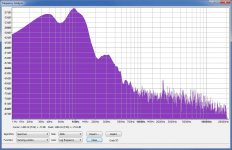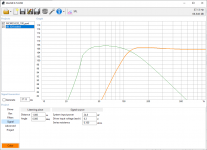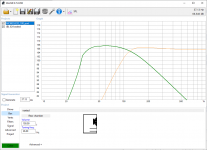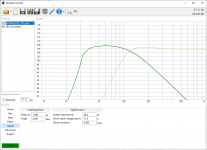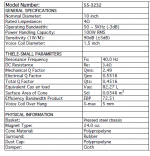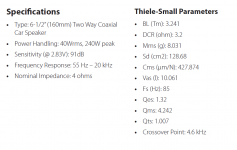This is a subwoofer upgrade to my normal pair of 6" car speakers in my arcade cabinet. I'm hoping to hear the 38Hz bump and more of the 100Hz bump in the attached sound effect.
I've bought the parts now but looking for any advice or anything I've missed in my design. And a check on my power supply.
MCM 55-3232 10" woofer
JBL 624 6" coaxial 2ways
Nobsound TPA3116 2.1 amp. 2x50W +100W
Douk audio 24V 6A power supply
Here are my winISD graphs.
I've put 2nd order butterworth at 120Hz for the crossover.
First question:
I've set the signal level as 39W for the sub, which is just hitting xmax (5mm) at 50Hz. And then for the pair of JBLs an appropriate level is 25W which gives a driver voltage of 6.3V
Does this mean: 2x 12.5W ? ie each driver 6.3V/3.2ohm =2A ( =12.5W)
and for the 10": 11.5V/3.4 = 3.4A (39W)
Is my 24V 6A power supply deficient in amperage? I chose it looking at the power 150W thinking I'd be running 2x25W + 80W or something like that.
Do these numbers mean that a more appropriate power supply would be 12V-10A or 18V-10A ?
I've bought the parts now but looking for any advice or anything I've missed in my design. And a check on my power supply.
MCM 55-3232 10" woofer
JBL 624 6" coaxial 2ways
Nobsound TPA3116 2.1 amp. 2x50W +100W
Douk audio 24V 6A power supply
Here are my winISD graphs.
I've put 2nd order butterworth at 120Hz for the crossover.
First question:
I've set the signal level as 39W for the sub, which is just hitting xmax (5mm) at 50Hz. And then for the pair of JBLs an appropriate level is 25W which gives a driver voltage of 6.3V
Does this mean: 2x 12.5W ? ie each driver 6.3V/3.2ohm =2A ( =12.5W)
and for the 10": 11.5V/3.4 = 3.4A (39W)
Is my 24V 6A power supply deficient in amperage? I chose it looking at the power 150W thinking I'd be running 2x25W + 80W or something like that.
Do these numbers mean that a more appropriate power supply would be 12V-10A or 18V-10A ?
Attachments
Last edited:
Huh, now I'm curious about this as well. I've always thought of it as "total watts in must be greater than total watts out", never looked at it as amps in vs amps out; but I can't fault your math or logic.
I'm hoping and thinking that something doesn't work that way though, because I have received the impression that maximum source voltage (within rating limits) is more important than available current, for delivering maximum power (e.g. you're better off with your existing 24v@6a than you would be with 18v@10a, or even 18v@1000a). But I sure can't back that up...
I'm hoping and thinking that something doesn't work that way though, because I have received the impression that maximum source voltage (within rating limits) is more important than available current, for delivering maximum power (e.g. you're better off with your existing 24v@6a than you would be with 18v@10a, or even 18v@1000a). But I sure can't back that up...
Huh, now I'm curious about this as well. I've always thought of it as "total watts in must be greater than total watts out", never looked at it as amps in vs amps out; but I can't fault your math or logic.
I'm hoping and thinking that something doesn't work that way though, because I have received the impression that maximum source voltage (within rating limits) is more important than available current, for delivering maximum power (e.g. you're better off with your existing 24v@6a than you would be with 18v@10a, or even 18v@1000a). But I sure can't back that up...
I've done some testing on cheap wallwarts in the past to weed out the bad ones eg supposed 12V-3A actually more like 1A. On those the voltage drops as the current limit is reached.
I wonder if similar would happen with my 24v-6A, eg it might continue above 6A but with falling voltage (which wouldn't be a problem for this system).
I paid more than I wanted to get this PS right away on amazon prime, so I guess I'm covered if I test it and it blows up instead of degrading gracefully. I mean it should be short circuit protected right? So I can try it across eg a 3ohm load (after 6ohm and 4ohm).
